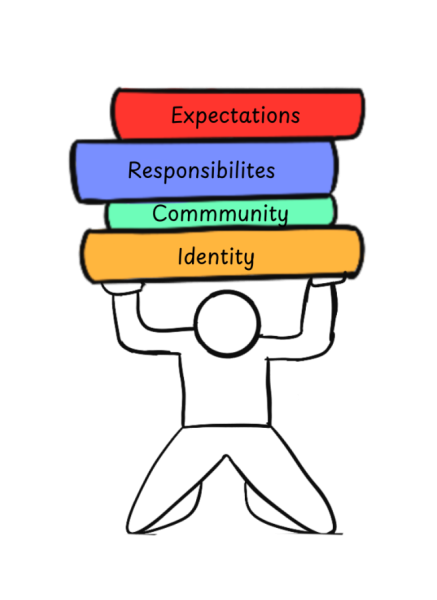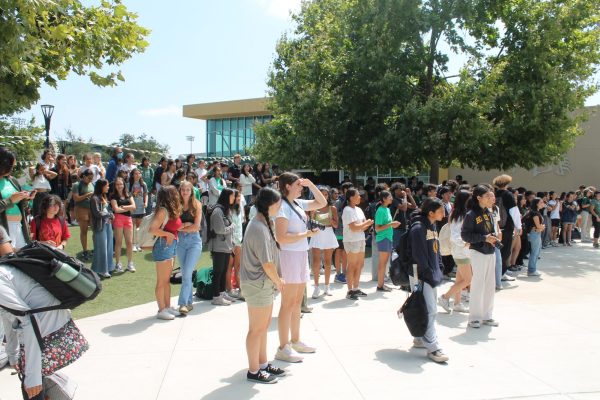Self-pacing or self-fulfilling prophecy
Asynchronous days provide students with many benefits, but not without disadvantages
We need to learn at our own pace
Asynchronous days were everything I needed in the midst of a hectic school week during remote learning. I loved the ability to choose when I wanted to complete my work and when I wanted to take a break. Especially now, with an increased course load and additional stress from in-person tests, I need more time to work on homework and study.
Asynchronous days offer a solution to this issue, allowing students like me to finish their work at their own pace. Ultimately, every student learns differently, and asynchronous learning days allow students to use their time based on their needs.

(Illustration by Saira Ahmed)
In-person learning has benefits, such as allowing students to ask teachers questions and engage in face-to-face discussions with their classmates. However, having a day of asynchronous learning would provide a break from the stress caused by quizzes and tests.
Yet, exams are not the only source of stress for students. Public speaking, interactions with friends and general pressure can add to a student’s anxiety level. A break is necessary after facing difficulties at school or feeling drained, according to Child Mind Institute.
This year, most of my assignments are already introduced on digital platforms that can be accessed at home and do not require collaboration with peers. There is no real reason for me to be present all five days when my schoolwork can mostly be done online. To ensure students remain productive during asynchronous days, teachers can assign work or readings that they can complete at home, just as they did during distance learning.
Furthermore, providing students with the freedom to take asynchronous days in the direction they choose can help them improve their time management skills, according to the University of St. Augustine for Health Sciences. When we had asynchronous days two years ago, I could create my own schedule for my day and set certain timeframes for when I would do schoolwork, go for walks and call my friends. The opportunity to create and organize my own schedule shaped me into a more productive and organized student. I still carry some of those time management strategies with me to this day.
Currently, California requires students to physically be in school for 64,800 minutes every school year. If students need a break from school-related stress, they should advocate for changes to the instructional time requirement. Just as the bill for the later start time was implemented, people must advocate for the changes they hope to see.
A one-day break from four days of hard work is a necessary part of our schedule. With an asynchronous day, students will be able to learn at their own pace, take a break from the pressures that school brings and develop better study habits.
Asynch learning creates out-of-sync students
Asynchronous days are one of those ideas that sound beneficial in theory, but are ultimately unproductive and inefficient in practice.
Having a skinny day every Monday provides me with a sense of my expectations for the week, so I can meet with all my teachers and plan out my schedule accordingly. It creates structure and organization, while also helping me develop a solid work-life balance.
Even if we implement an asynchronous day at the start of every week, our workload will not decrease. A day of remote learning would leave me feeling aimless, forced to cope with an unpredictable workload that prevents me from structuring my week effectively.
In addition, even though our asynchronous day was technically a “work period,” the lack of teacher supervision caused it to feel like just another weekend. Because of this, I found that I was much less productive because of the sheer amount of time on my hands.
The simple act of changing into my outfit and biking to school provides a sense of regularity to my schedule. At school, I am more motivated, as I can avoid the distractions that come with being alone in my bedroom. I am able to create a separation between my school and home lives and dedicate my time to both within their respective settings.

(Illustration by Karuna Chandran)
To add on, teachers already face the challenge of teaching an entire year’s worth of curriculum, while also incorporating enough projects and creative assignments to make their classes engaging. This is especially important for AP classes, where teachers have a set list of learning targets they need to cover for students to be successful on the AP test. Every class period counts.
If we implemented an asynchronous day, teachers would either have to prioritize the curriculum over engagement to prepare their students, or students would have to make up for the lack of class time by completing more independent assignments.
This entirely defeats the purpose of taking advanced classes in high school: for students to be able to enrich their educational experience through immersion in a specific subject. I could not imagine taking AP Biology last year without the labs and activities that allowed me to connect with the material and envision myself as a scientist conducting my own data and research.
In a world that is already so digitized, we cannot take away in-person learning time that provides students with more hands-on educational experiences and an organizational structure to the school week. A day off sounds like a blessing — but in reality it may be a curse.
It is senior Saira Ahmed's third (and final) year on The Epitaph, but she is still looking forward to writing about the same topics as she did two years...
Now a senior, Karuna is so excited to return once again to the paper, this year as the Managing Editor. She hopes to help staff members express themselves...












